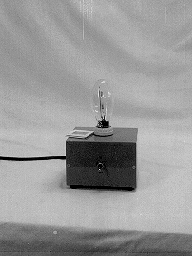

PURPOSE: High-pressure sodium lamp shows both emission and absorption line spectra.
DESCRIPTION: Hand out, for the students to keep, 1"x2" pieces of replica diffraction grating material. Look at the bulb with the diffraction grating about one inch in front of your eye as the bulb warms up to see the following: (1) Several relatively weak lines are initially seen, both from sodium and from mercury, which is used as a seed to get the lamp started. (2) As the bulb warms up collision broadening of the lines occurs, so the weak lines become much brighter and spread out to form a nearly continuous spectrum. (3) When the lamp is operating at full temperature, "cooler" sodium vapor around the periphery of the bulb absorbs light at the frequency of the sodium doublet, producing a nice dark absorption line.
It takes a few minutes for all this to happen, but may be worth it for the various types of spectra seen. While the spectrum is developing, make use of this time by telling your students the story of the discovery of helium on the sun, and why it is named helium (after the Greek god Helios). It is not true that people went to the sun and discovered helium when they breathed it and their voices went up.
SUGGESTIONS:
REFERENCES: (PIRA 7B10.10) See Demonstration Reference File for information about this lamp and its power supply.
EQUIPMENT: Mounted high-pressure sodium lamp with hand-held give-away replica diffraction gratings.
SETUP TIME: None.
 |  |  |  | 
|